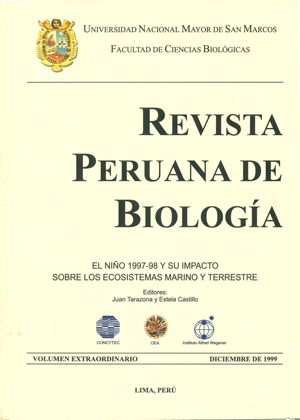Impact of "El Niño 1997-98" on shallow marine ecosystem of the Peruvian central coast
DOI:
https://doi.org/10.15381/rpb.v6i3.8427Keywords:
Marine ecosystem, macrobenthos, phytoplankton, Ancon Bay, El Niño 1997-98.Abstract
The characteristics of intensity, and untimely of "El Niño 1997-98" answer, manifested by superficial phytoplankton, rocky shore macroalgae, and soft bottom macrobenthos were analyzed from December 1996 to August 1998 in Ancon Bay (11 °46' LS and 77°11' LW). A significative increase of both, temperature since April (17,4°C), and oxygen (2,46 mLL-1)from May 1997 in the bottom of the study area, characterized this event. In superficial phytoplankton, the presence of indicator species of warm oceanic water, and an unusual increase of both dinoflagellate and microflagellate density at the beginning of April 1997 were recorded since January. The density of Chondracanthus chamissoi population reached 2684 ind.x32 m ' of shoreline in October 1997, and the proportion 01 gametophytes increased during 1998. The density and species number 01 soft bottom macrobenthos reached maximum values of 90 indo x 0,04 m-2, and 20 species in June, and November 1997 respectively; these variations have a good correlation with intensity changes of "El Niño". The biomass reached its maximum value 0,55 g pssc x 0,04 m-2 in January 1998. Finally, it is showed that "El Niño 1997-98" biological impact was lesser than that of 1982-83 however the similarity of intensity in both events; and that shallow water showed early and reliable indicators of "El Niño", in both, the phytoplankton as in the benthos. Moreover, the presence of a post-Niño period showed that "El Niño" impact on population and communities might be complex.Downloads
Downloads
Published
Issue
Section
License
Copyright (c) 1999 Juan Tarazona B., Aldo Indacochea, Sonia Valle, César Córdova, Noemí Ochoa, Wilbert Serrano, Tania Peña

This work is licensed under a Creative Commons Attribution-NonCommercial-ShareAlike 4.0 International License.
AUTHORS RETAIN THEIR RIGHTS:
a. Authors retain their trade mark rights and patent, and also on any process or procedure described in the article.
b. Authors retain their right to share, copy, distribute, perform and publicly communicate their article (eg, to place their article in an institutional repository or publish it in a book), with an acknowledgment of its initial publication in the Revista Peruana de Biologia.
c. Authors retain theirs right to make a subsequent publication of their work, to use the article or any part thereof (eg a compilation of his papers, lecture notes, thesis, or a book), always indicating its initial publication in the Revista Peruana de Biologia (the originator of the work, journal, volume, number and date).






